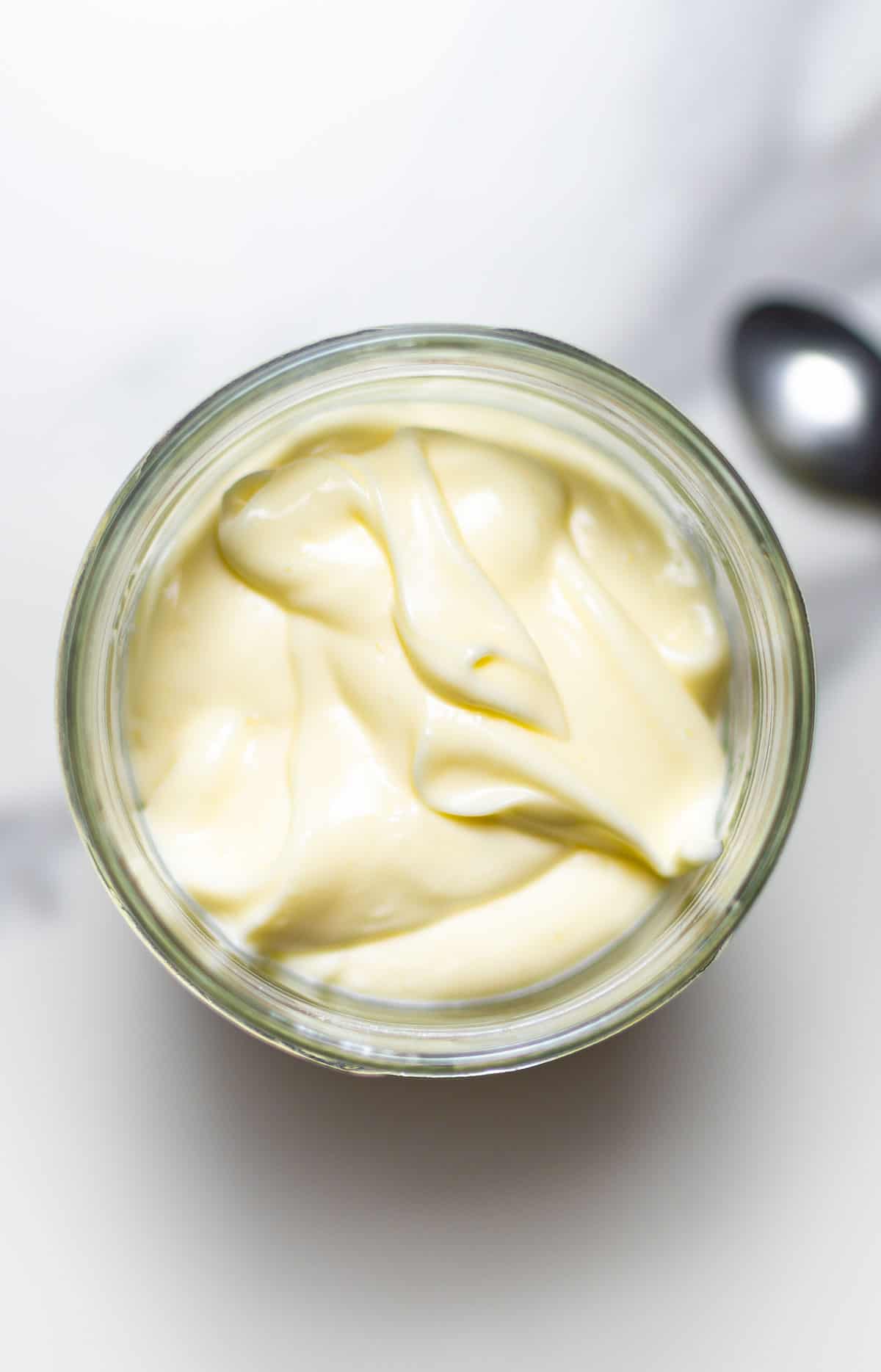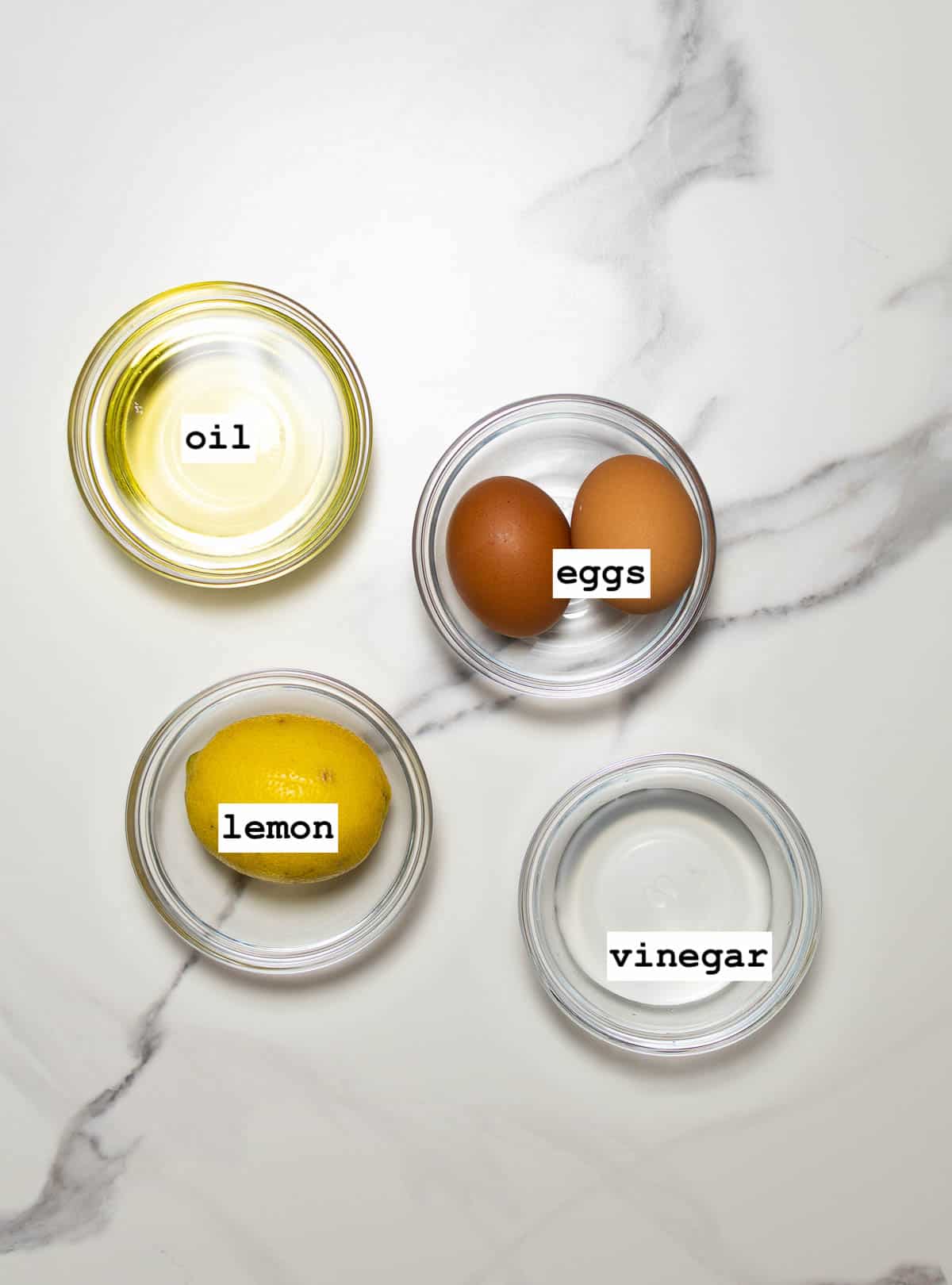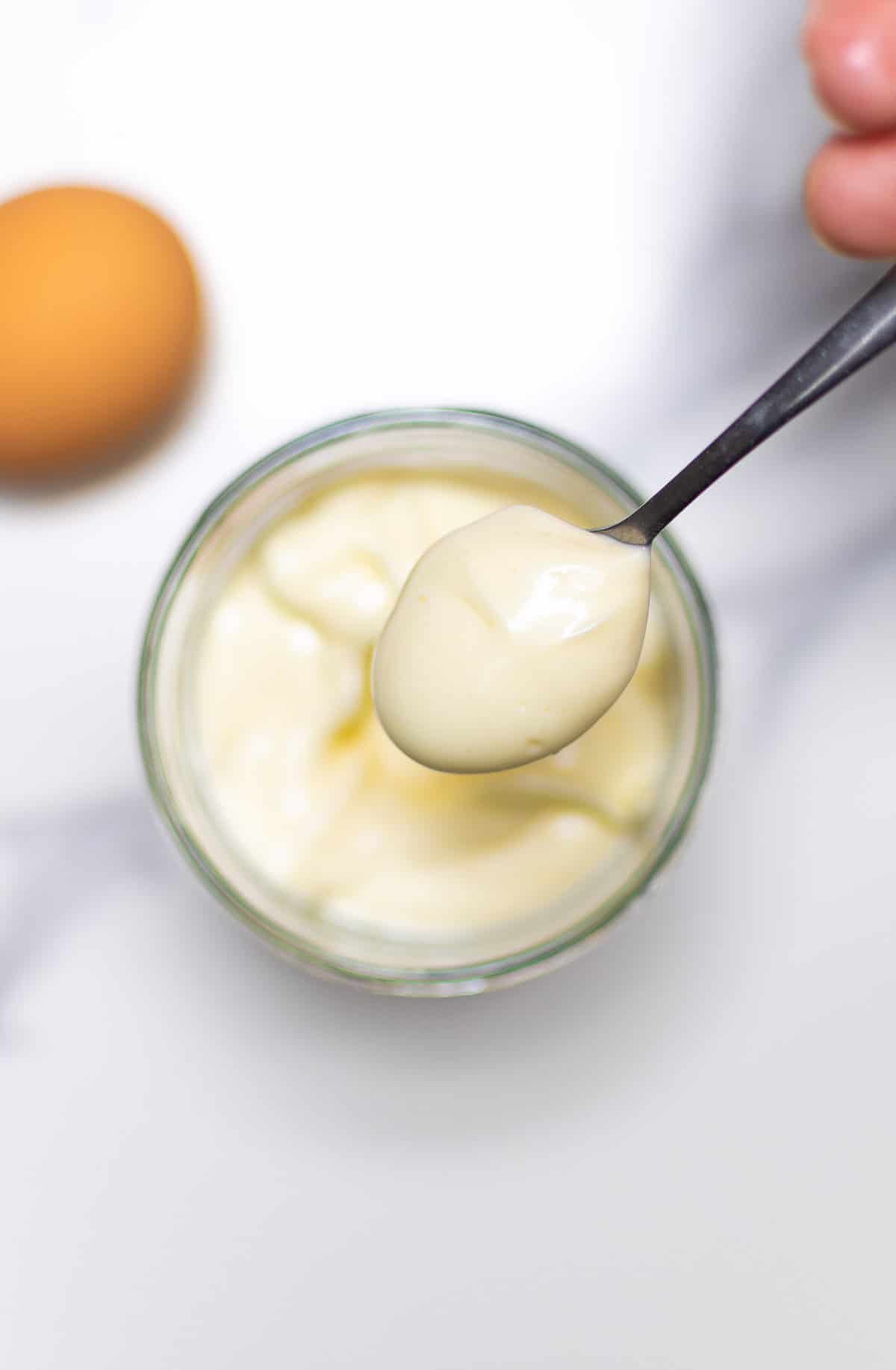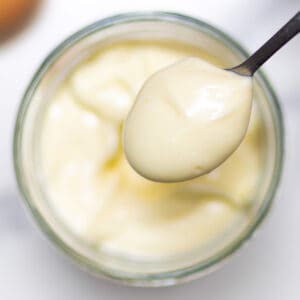This Homemade Mayonnaise Without Mustard recipe is super delicious, quick, and easy to make. It is the perfect alternative to any usual store-bought mayo in the supermarket. Perfect for sandwiches, burgers, grilled chicken, and any type of meat you want! It has the perfect texture and creaminess, thick and not liquidy mayo!

let me tell you something about myself! I am not that guy that puts mayo on anything edible, and I'm not that guy that loves any kind of mayonnaise! I'm a little picky about my condiments and that's why I exclusively used a French-made mayo called Lesieur until I developed this recipe after several tries and failures.
I wanted my mayonnaise to be as close as possible to that French-made mayonnaise I have been eating since I was a little girl. So my conditions were it has to be thick in consistency and not runny mayo, it must include only a few ingredients, and of course tasty!
Want something to go with this Homemade Mayonnaise? Check out my Grilled Buffalo Chicken, Instant Pot Chicken Drumsticks, Leek And Mushroom Quiche (Gruyère Cheese), or my ultimate Quick & Easy Gouda Mac and Cheese.
Jump to:
🌟 Why you'll love it
- Fresh and Flavorful
- Preservative-Free
- Quick and Easy

🍽️ Equipment needed to make this recipe
- Immersion Blender / Hand Blender
To make this mayonnaise a success you'll need one thing only and maybe it is the most important one!! which is an immersion blender ideally if you have it of course the KitchenAid blender with the 4-blade attachment! this will ensure you're getting the most consistently accurate mayonnaise as mine possible.
🧾 Ingredients to make this Homemade Mayonnaise
This is a homemade mayonnaise without mustard, Mustard gives a little bit of heat to the mayo, and I don't like that! if you do like it feel free to add some tablespoons to the recipe!
This is an overview of the ingredients needed to make this homemade mayonnaise, The whole list and instructions are in the recipe card below!

Mayonnaise is made using basic ingredients that you probably already have in your home. You will require the following items:
- Eggs: There is no mayonnaise without eggs, so this is the minimum requirement to make a good mayo! In this recipe, I used a whole egg (yolks + whites)
- Oil: In the original Lesieur's recipe they used vegetable oils such as colza oil, canola oil,.. etc. but in mine, I'm going to use the oil that is available in every staple house, the sunflower oil. In addition to this, I like the neutral flavor of this oil over any other flavored oil!
- Vinegar or lemon juice: A little acid, such as apple cider vinegar, white vinegar, or lemon juice, not only adds a fantastic taste to the mayonnaise but also helps to stabilize the mixture. personally is used and still uses the white vinegar!
- Salt: Just add a pinch of salt for flavor and that's it.
👩🏻🍳 How to make Homemade Mayonnaise
It's worth mentioning that there are several methods for making homemade mayonnaise. The procedures will be the same whether you use a blender bowl/jug, a small food processor, or an immersion blender. As is my personal choice, I made this mayo with an immersion blender.

Note: Although I've heard that ingredients should be used at room temperature, I've tested both chilled and room temperature eggs and haven't really noticed much of a difference.
- Combine the ingredients: You can start by adding the whole egg into a small bowl, alongside salt, oil, and a little bit of vinegar! let's mention that some people prefer adding salt til the end of the process, I've tried both methods and haven't seen any difference, so you are free to season your mayo whenever you want.
- Blend: Plunge your immersion blender into the bottom of the bowl or the jar, and mix at low speed in pulsations (1 sec pulses). Do this 3 to 5 times and also move your immersion blender head in an up-and-down movement, this will ensure all the oil will be mixed into the egg.
- Blend until thickened: As you keep mixing you'll notice that the mayo starts thickening at that moment if you want your mayo to be super thick ( like cheesy thick) you can add ⅓ cup of oil but if you prefer the initial texture, stick with the recipe!
- Season: Taste your mayonnaise, and adjust the seasoning to your liking! some people add mustard and black pepper to their mayo! but this is an original mayonnaise that doesn't contain any of that! so let's keep things simple.
- Refrigerate: Scoop your mayonnaise into a small glass box and air-tight it, transfer it to the fridge, and let it chill for a moment! I like my mayonnaise to be chill and firm!

💭 Tips for making homemade mayonnaise
Here are some tips and tricks to help you make the best homemade mayonnaise:
- For best results, you are going to need to use fresh ingredients. Fresh ingredients are the most important thing in having a good mayonnaise, Fresh eggs, fresh olive oil, good quality vinegar,..etc
- Use room-temperature eggs to get the best results for your mayo, otherwise, it will not emulsify.
- Some people (majority of them) prefer to add the oil in the last step of the process, BUT I've found out that it doesn't really matter when you add the oil, I prefer to add everything at the start and just add a little bit of oil to thicken the mayo as I wish to.
- I prefer to use tight jars or bowls, this helps emulsify your ingredients much better than using large bowls. Try to use the jar that comes with your immersion blender if you have that attachment.
📋 FAQs
For the making of mayonnaise, eggs are required. The risks of using raw eggs are minimal, however, there is a possibility that the egg may contain Salmonella bacteria.
Keep in mind that mustard adds a little bit of heat to the mayo! so if you prefer it that way you can definitely add Dijon mustard, or English mustard to it!
Although you can exclude mustard from your homemade mayonnaise recipe, keep in mind that it is one of the fail-safe ingredients to help emulsify.
The refrigerator shelf life of this mayonnaise recipe is approximately one week. However, you can extend the shelf life of mayo by Lacto fermenting it. (For instructions on Lacto-fermenting the mayo, see the recipe suggestions above.)
The only option I've heard of is to ferment it by adding a tablespoon of whey for every two eggs. If you absolutely need to keep your mayo for more than a week, it could be worth a shot. Why would you, though? Making mayo using a stand mixer or hand blender just takes five minutes, and if you only use one egg yolk, you may create as little as a cup at once. It's almost too simple to consume a cup of homemade mayo every day for a week because it's so good.
🍞 Best Side Dishes to Go with Homemade Mayonnaise
- Grilled Buffalo Chicken
- Instant Pot Chicken Drumsticks
- Instant Pot Chicken Tenders
- Instant Pot Chicken Fajitas
- The BEST Homemade Anchovy Pizza Recipe
- Crispy Honey Chicken
- Steak Egg and Cheese Bagel Recipe
If you are looking for more sauces and condiments, be sure to check also my Homemade Buffalo Sauce, and this Spaghetti Seasoning.
📖 Recipe

Fail-Proof Homemade Mayonnaise Without Mustard
Equipment
- 1 hand blender
INGREDIENTS
- 1 egg
- 1 ¼ cup sunflower oil
- 1 teaspoon lemon juice
- 2 teaspoon white vinegar
- ½ teaspoon salt
INSTRUCTIONS
- Egg should be added to a small food processor bowl and processed for 20 seconds. Add salt and vinegar. 20 more seconds are spent processing.
- After cleaning the bowl's sides and bottom, switch on the food processor, and start adding the oil carefully, a little at a time, until about a quarter of it has been added (this is critical for proper emulsification).
- You can relax your rules a bit after you see that the mixture is starting to thicken and emulsify. Continue adding it gradually while the processor is running, but increase the amount to a very thin stream rather than drips of oil.
- After adding all the oil, scrape the bowl's bottom and sides, then process for an additional 10 seconds. Once the mayonnaise has been properly seasoned, add salt, lemon juice, or additional vinegar as desired.
- Remember to gradually feed in extra oil while the processor is running if the mayo seems too thin.
NOTES
- Homemade mayonnaise can be kept for up to a week in the refrigerator when covered.
- Choose fresh, well-refrigerated, clean grade A or AA eggs with undamaged shells when picking raw eggs for homemade mayonnaise.
- Olive oil: Olive oil can be a touch overbearing, so choose one that is light and fruity. You might also choose to use olive oil for only half of the recipe's oil calls for it and something more neutral for the other half.
- Fixing Broken Mayonnaise: Although we have never experienced a recipe for mayonnaise breaking on you, don't worry! You ought to be able to resolve the issue.
- Note that this recipe calls for no mustard and no water added! don't be afraid just follow the steps and everything is going to be just okay and you'll get the perfect mayonnaise you wanted.





jhonny says
this homemade mayo looks absolutely fantastic and thick! def gonna try this!
Imsen says
Hi! glad you liked it!
Sara Welch says
I never knew how easy it was to make your own mayonnaise from home! Such a quick and easy recipe without all the preservatives; a great recipe to have on hand, indeed!
Imsen says
this is why i love making everything at home! no preservatives and chemicals!
nancy says
this Homemade Mayonnaise looks delicious. i like that it is easy and simple without mustard
Kathleen says
Big fan of homemade condiments. Will be trying this mayo ASAP.
Anjali says
Love this homemade mayo recipe!! It tasted so fresh and light, and I love that it was a little healthier than the store bought versions!
Sonal Gupta says
I made a batch using your RECIPE! Loved how easy it was and so creamy!
Amy says
Thank you so much for sharing! I have wanted an alternative oil mayo recipe and this was perfect!!
justi says
Had a moment when making tuna and realized I was out of mayo, this worked great
Renee says
This homemade mayo is so creamy, and it's dead simple to make! Thanks!
Charles says
Hi,
I like this recipe for its simplicity. Plus its a little decadent! Thanks for sharing!
Jacque Hooper says
I love how healthy and easy this recipe was! Turned out perfectly creamy and without added preservatives! Definitely, a new favorite mayo recipe!
Imsen says
Thank you!
Ieva says
It was my first time making mayonnaise and I am so pleased with the results. Super creamy and delicious!
Ned says
This was perfect! I never want to buy store bought again! Thank you for the great recipe!
Rose says
I tried making this using someone else's recipe awhile ago and it never emulsified so I threw it away and gave up.
I just tried your recipe and it turned out fantastic! So thick and creamy! I live where they only sell sweet mayo and ordering the good mayo online is so expensive. Now I don't have to and this tastes just as good and is better for me. Thank you so much for your recipe and instructions.
Imsen says
Thank you so much for your kind feedback about the recipe! and I'm so glad you liked it 🙂
Kushigalu says
Homemade is always the best, and this looks fantastic. Thanks for sharing.
Beth says
Homemade mayo tastes so much nicer than store bought. I love how silky smooth it looks.
lily says
Wow making homemade mayonnaise looks so easy! I can't wait to try this recipe with a curry chicken salad or an egg salad sandwich.
Dannii says
This was so easy to make, and delicious. I just wish I had of made more.
Kushigalu says
Homemade is always the best. This mayonnaise looks amazingly delicious.
Gina Abernathy says
An easy recipe to keep in your file. I had no idea it was so easy to make mayo at home. This will certainly come in handy.
Kate says
Newbie cook here, and I was pretty nervous about trying this one. Came out amazing. Using it instead of store-bought Mayo and will make again!
Tavo says
Great mayo recipe and so easy to make! Loved it!
Ali says
I didn’t know it was so easy to make mayo at home! I am always eating mayo with homemade fries, I can’t wait to try this recipe, I bet it is so much better than storebought mayo!
Rosemary says
Loving this homemade mayo....can't wait to make it! Cheers!
Mahy says
I love how easy it is to make this mayonnaise. Just what I have been looking for!
Claire says
Taste is fantastic! How long is this good for in the fridge?
Imsen says
Hi, glad you liked the recipe! the homemade mayo is good for up-to a week in a fridge!
Dionne says
I have always used mustard when making mayonnaise.... It is time to try something new... Looks amazing!
Sandhya S says
I ran out of mayo, so used your recipe to make some at home.. It was really so easy peasy!
Mélanie says
I made it once and it was really good, but now I make it again and it doesn't want to thicken. Don't think I did anything different, though it is really warm and the eggs were outside, can this be the reason or is there something else?
Imsen says
Hi Melanie, glad you liked the recipe! for the thickness it has a lot to do with the quality of the eggs and the oil used! companies that produce these two things really mess a lot of times with the quality for obvious reasons! :/